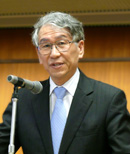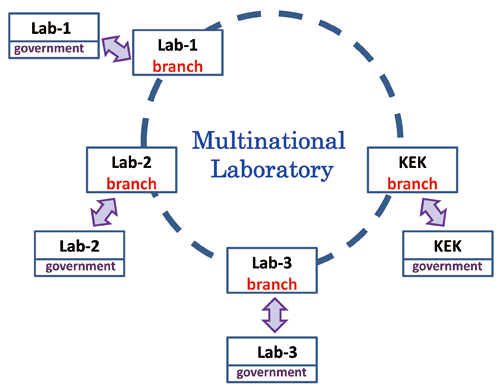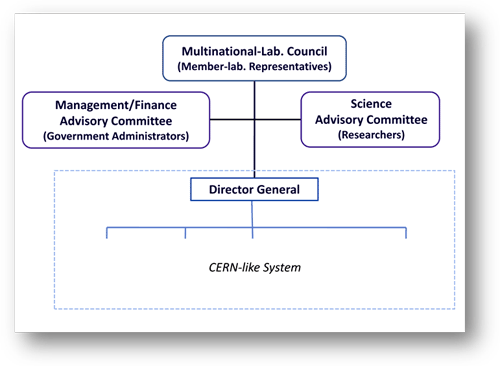DG's Corner
Definition of Global Projects and Distinction
between International and Global Projects
04 Jun 2010

Atsuto Suzuki
Director General
Now that the LHC (Large Hadron Collider) at CERN has begun its continuous operation, the scientists of the HEP (high energy physics) communities in the world are all excited by the long-awaited beam collisions. What kind of windows will open for new physics? Our expectations are mounting day by day.
In synchronization with the launch of LHC operation, a new discussion seems initiated as to how to forge the organization structures for future international HEP projects beyond the LHC. At the last meeting of the FALC (Funding Agency for Large Colliders) which was held in Mumbai in January 2010, an issue - "Definition and Distinction between International and Global Projects" was put on the table for extensive discussion. Behind this topic lie the perceived difficulties in completing large HEP projects which are anticipated in our future. Specifically,
(1) the project size is growing bigger and bigger;
(2) the project cost is growing higher and higher; and
(3) the project time span is becoming longer and longer.
In my view, the ICFA Guidelines*1 for the Interregional Utilization of Major Regional Experimental Facilities for High-Energy Particle Physics Research (hereafter ICFA GDL) would play a key role in defining what we consider global projects and their distinction from the present form of international projects in HEP. The ICFA GDL was originally put forth in 1980 and was re-endorsed in 1993. All international projects in HEP at present adopt ICFA GDL as the common policy for their executions. This guideline comprises six articles,
"considering that in the future major experimental facilities for high energy particle physics research, notably the very largest particle accelerators and colliding beam machines, are likely to be few in number, probably only one of each type of the very highest energy, and that these machines will be located in different regions of the world, and recognizing that experimental physicists from all regions will wish to gain access to these few machines in order to pursue their research".
In particular, the article 5 conveys a powerful message. It reads as follows -
"operating laboratories should not require experimental groups to contribute to the running costs of the accelerators or colliding beam machines nor to the operating costs of their associated experimental areas".
In my opinion, the ICFA GDL articles 1,2,3,4 and 6 should commonly apply to both the international projects and our future global projects. However, the ICFA GDL-5 will have to be annotated, or rephrased, in case of future global projects. In our future, there will be only a handful of major HEP facilities, compared to the situation in 1980s and 1990s. At the same time, the project costs and operation costs are skyrocketing. Under these circumstances, the definition of global projects should reflect the new framework of new governance which makes it affordable and acceptable for us to realistically share not only the construction costs but also the running/operation costs among the participating laboratories or countries.
It is my belief that the governance for the global projects must be established on the balanced partnership between the project management, which is located at a central host institute, and the participating institutes, which are distributed across the world. In this sense, the concept of geographical region like Europe, Asia, Americas could require a major revisiting. All countries and/or laboratories are possible to take part in the global project with an equal opportunity for research yet with varying magnitudes of participation in governance / construction / operation, which depend on their resources to share with corresponding obligations and duties. On the basis of these notions for global projects, proposed here is a framework of a global project laboratory (Multinational-Lab) and the scheme for its organization:
- Each of the HEP-labs in the world, which wishes to participate in the project - a Multinational-Lab, sets up its branch within that Multinational-Lab as shown in Fig. 1. These participating HEP-labs are called member-labs.
- This Multinational-Lab is virtually built inside the host laboratory.
- The council of this Multinational-Lab comprises the representatives from the member-lab branches. Note here that the academic members (scientists) are to take the responsibility on the governance of Multinational-Lab.
- According to the agreement on the governance policy, the member-labs contribute in sharing the human resources (scientists, engineers, technical staff and administrative staff), and the financial resources (common fund with a certain overhead and in-kind contributions). Composition and amount of these contributions of human and financial resources would depend on the project stage in progress (construction, commissioning and operation) as well as on the type of member-labs (hosting or else).
- The member-labs have to work out the adequate working conditions (salary, insurance, pension and retirement plans...) for the employees who work at their branches in suitable accordance with their own regulations and the international standard.
- Voting rights etc for representatives in the Council shall put forth in accordance with the agreement, reflecting the relative amount of contributions made by the member-labs.
- In order to assure that experimental physicists across the world gain access to the projects, various kinds of participating form should be arranged with being like a member, an associate-member, an observer, a non- member and so on.
- The organizational chart and the reporting scheme, as shown in Fig. 2., would be much similar to those of CERN.
- The scheme of this Multinational-Lab is expected to help streamline the processes for site-selection and inter-governmental negotiations on the required treaties and agreements.
While admittedly rather preliminary, I think this scheme can offer a reasonable starting point for our more systematized thought process toward our future global projects. I would like to invite discussion by interested members of the world HEP communities.
Thank you very much for your kind attention.
Atsuto Suzuki, KEK Director General
*1 http://www.fnal.gov/directorate/icfa/icfa_guidelines.html

Fig. 1 Framework of Multinational-Lab.

Fig. 1 Organization/Steering Scheme.